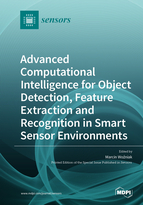Advanced Computational Intelligence for Object Detection, Feature Extraction and Recognition in Smart Sensor Environments
A special issue of Sensors (ISSN 1424-8220). This special issue belongs to the section "Intelligent Sensors".
Deadline for manuscript submissions: closed (30 April 2020) | Viewed by 137121
Special Issue Editor
Interests: computational intellgence; neural networks; image processing; expert systems
Special Issues, Collections and Topics in MDPI journals
Special Issue Information
Dear Colleagues,
Recent years brought a vast development in various methodologies for object detection, feature extraction and recognition both in theory and practice. When processing images, video or other multimedia we need efficient solutions to perform fast and reliable processing. Computational intelligence is used for medical screenings where the detection of disease symptoms is carried out, in prevention monitoring to detect suspicious behavior, in agriculture systems to help with growing plants and animal breeding, in transportation systems for the control of incoming and outgoing transportation, for unmanned vehicles to detect obstacles and avoid collisions, in optics and materials for the detection of surface damage, etc. In many cases we use developed techniques that help us to recognize some special features. In the context of this innovative research on computational intelligence, it is my pleasure to invite you to contribute to this Special Issue, which presents an excellent opportunity for the dissemination of your recent results and cooperation for further innovations.
Topics of interest:
- Bio-inspired methods, deep learning, convolutional neural networks, hybrid architectures, etc.
- Time series, fractional-order controllers, gradient field methods, surface reconstruction and other mathematical models for intelligent feature detection, extraction and recognition.
- Embedded intelligent computer vision algorithms.
- Human, nature, technology and various object activity recognition models.
- Hyper-parameter learning and tuning, automatic calibration, hybrid and surrogate learning for computational intelligence in vision systems.
- Intelligent video and image acquisition techniques.
Assoc. Prof. Marcin Woźniak
Guest Editor
Manuscript Submission Information
Manuscripts should be submitted online at www.mdpi.com by registering and logging in to this website. Once you are registered, click here to go to the submission form. Manuscripts can be submitted until the deadline. All submissions that pass pre-check are peer-reviewed. Accepted papers will be published continuously in the journal (as soon as accepted) and will be listed together on the special issue website. Research articles, review articles as well as short communications are invited. For planned papers, a title and short abstract (about 100 words) can be sent to the Editorial Office for announcement on this website.
Submitted manuscripts should not have been published previously, nor be under consideration for publication elsewhere (except conference proceedings papers). All manuscripts are thoroughly refereed through a single-blind peer-review process. A guide for authors and other relevant information for submission of manuscripts is available on the Instructions for Authors page. Sensors is an international peer-reviewed open access semimonthly journal published by MDPI.
Please visit the Instructions for Authors page before submitting a manuscript. The Article Processing Charge (APC) for publication in this open access journal is 2600 CHF (Swiss Francs). Submitted papers should be well formatted and use good English. Authors may use MDPI's English editing service prior to publication or during author revisions.







